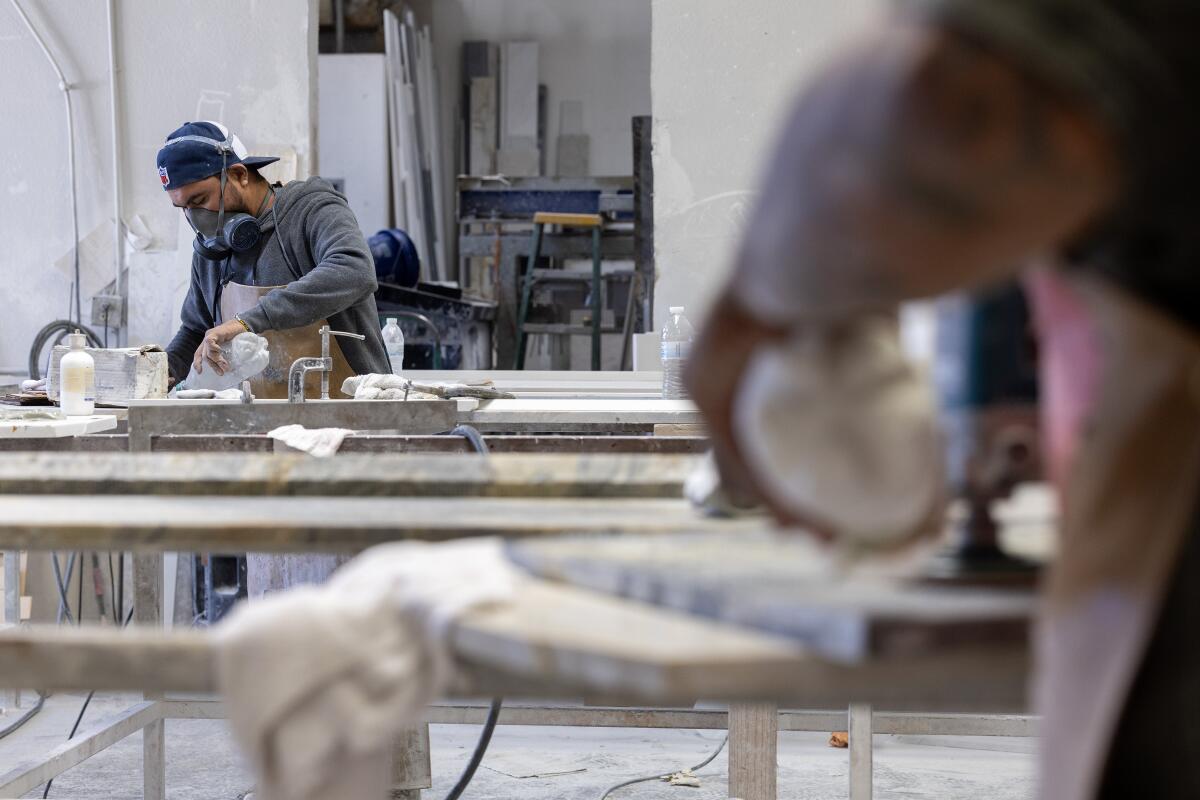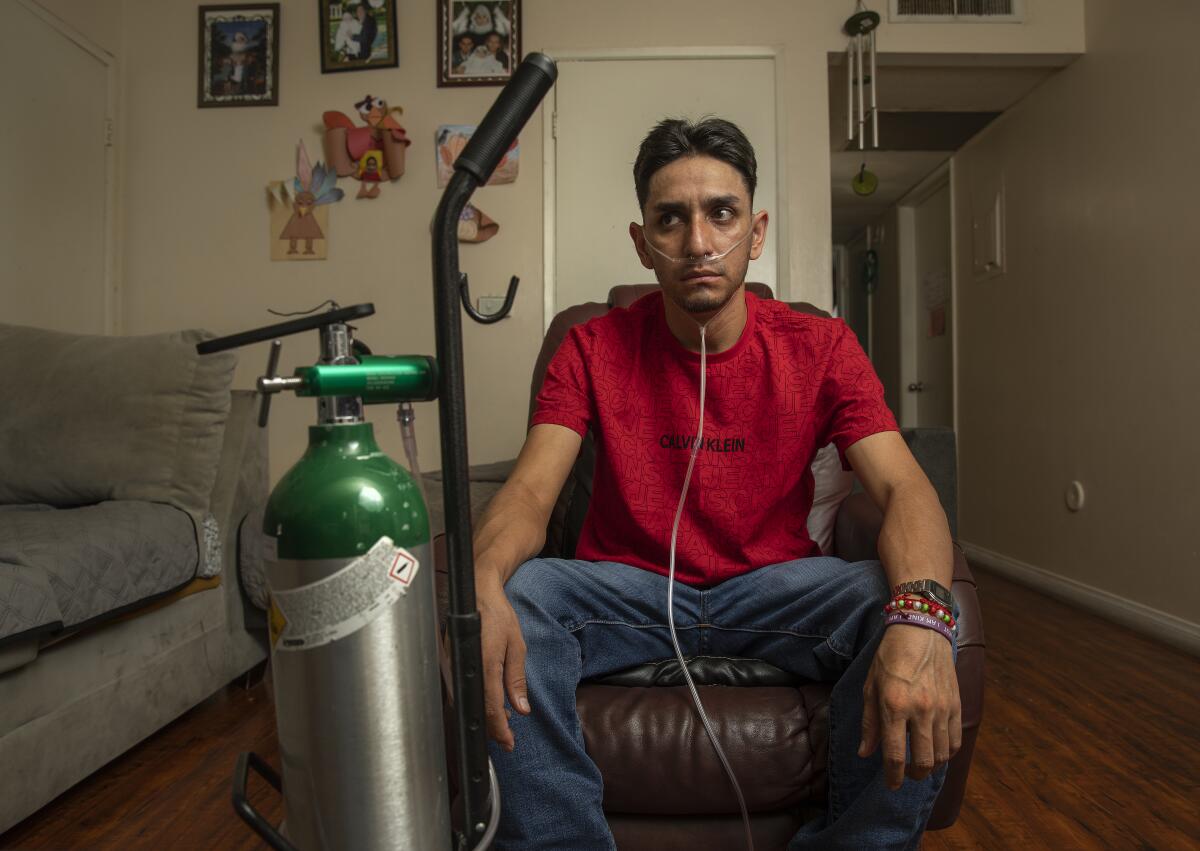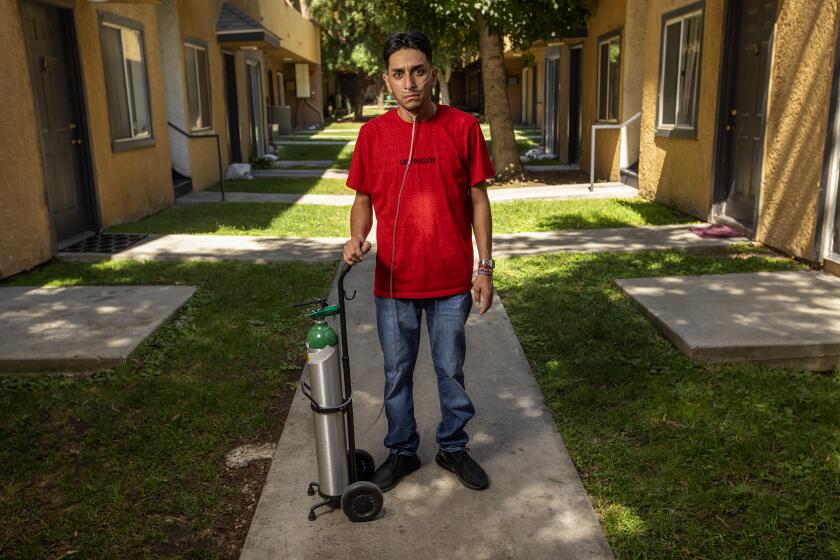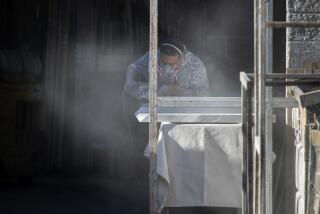California embraces emergency rules to protect countertop workers from incurable silicosis

- Share via
The deaths of young workers who cut kitchen and bathroom countertops prompted a state board to back emergency safety measures Thursday aimed at preventing silicosis, an incurable lung disease that has risen along with the booming popularity of engineered stone.
The artificial material is made of crushed stone bound together with resin and can have silica levels exceeding 93% — much higher than in marble or granite. Workers who cut and grind engineered stone are at risk of inhaling tiny particles of crystalline silica that scar their lungs, leaving them struggling to breathe.
The recent eruption in silicosis cases has cut down men who have barely reached middle age. Across California, 100 cases have been tallied since 2019 among workers who cut countertops. At least 10 have died, with a median age at death of 46 years. Others are waiting for lung transplants.
Experts believe many more cases may have been misdiagnosed or left unreported.
“We have never seen something — at least in my lifetime — develop so rapidly,” said Dr. Robert C. Blink, a physician who is part of the Western Occupational and Environmental Medicine Assn., which petitioned for emergency protections. “Something really needed to be done. ... It’s a toxic epidemic.”
State regulators estimated that as many as 800 of the industry’s more than 4,000 workers could end up with silicosis if California failed to take protective action, and up to 160 were likely to die of the suffocating disease, according to a presentation at Thursday’s meeting of the California Occupational Safety and Health Standards Board. That would amount to “an industrial disaster” on a scale not seen in nearly a century, Cal/OSHA said in a report laying out the need for the measure.

The new, temporary rules adopted by the board are expected to go into effect by the end of this month. They are meant to provide “clear and specific requirements” for workplaces and eliminate loopholes that Cal/OSHA said had allowed employers to dodge safety requirements, according to the state agency’s report.
“This emergency measure simply must be implemented,” board member Joseph M. Alioto Jr. said ahead of the unanimous vote.
Under the emergency rules, employers will have to take measures to protect workers from silica whenever risky work is being performed, regardless of whether silica levels have been tested and found to be worrisome, Cal/OSHA said. That includes using water to tamp down dust during stonecutting and giving workers specific kinds of protective respirators.
The new rules also ban some dangerous activities, such as sweeping dry dust that may contain silica. They also require businesses to promptly report silicosis cases and lung cancers tied to silica exposure, a mandate meant to help the state track and respond to the problem more quickly.
Of particular importance is the ability to swiftly order dangerous shops to stop operating, said Dr. Robert Harrison of the California Department of Public Health. “It’s really critical to stop these exposures when there’s a hazard present — and not let it drag on for months,” he told the board Thursday.
The Agglomerated Stone Manufacturers Assn. , which represents engineered stone makers including Caesarstone, Cambria and Cosentino, voiced support for the California emergency measure, which was up for approval days after Australia announced it would impose a nationwide ban on the material.
“Fabricators” — those who cut, grind and polish the slabs — “can and do reduce the risk of developing silicosis if proper safety and health measures are in place to protect against inhalation of silica dust,” said Libby Sanchez, an association representative. “Without these standards, violators will continue to put workers in harm’s way,” Sanchez said.
The Silica Safety Coalition, which represents manufacturers, fabricators and others in the industry, also applauded the rules, saying they “will enable Cal/OSHA to swiftly take action against non-compliant fabricators.”
Other industry groups that represent stone fabricators argued the rules would hurt companies that are already complying with state rules and urged the board to delay its vote until amendments could be considered.
The rules will “place a huge burden on compliant fabricators who have a proven track record of employee safety,” said Ted Sherritt, the incoming volunteer president of the International Surface Fabricators Assn., which represents countertop fabricators.
Jim Hieb, chief executive of the Natural Stone Institute, told the board that increased requirements for personal protective equipment and other mandates could cost tens of thousands of dollars per company. Such financial burdens “could drive more business to those that do not comply,” he said.
Doctors speaking at the Thursday meeting urged the state board to press forward. Dr. Jane Fazio, a pulmonary and critical care physician at Olive View-UCLA Medical Center, grew teary as she described regularly having to give young men a diagnosis that amounts to “a death sentence.”
“I receive desperate phone calls daily from men who’ve never asked for help from anyone in their whole lives, asking me when they’ll get an organ” for a lung transplant, Fazio said.
“No amount of business is worth the lives lost and the suffering this is generating.”
The booming popularity of countertops made of engineered stone has driven a new epidemic of silicosis, an incurable lung disease, researchers have found.
The emergency rules now head to a state office that reviews proposed regulations to make sure they are legally valid. If they pass, they will go into effect by the end of December and remain in place for up to a year, Cal/OSHA staff said Thursday. During that time, the board can move forward with its usual process for passing new rules.
The new rules focus on protecting employees who cut, polish and carry out other hazardous tasks with artificial stone that contains more than 0.1% silica, or with natural stone that has over 10% silica. Including both will prevent businesses from simply switching from engineered stone to natural materials with similar risks, regulators said.
The existing safety rules, which were crafted based on silicosis risks in industries such as mining and sandblasting, have been a poor fit for the stone fabrication industry, which is dominated by small workshops with a handful of employees, the agency said.

The state rules have relied heavily on employers to do “relatively sophisticated” assessments to gauge silica exposure and then determine how to control it, an approach that is not well-suited to small businesses that typically lack the capacity to conduct “technically sound assessments,” Cal/OSHA found.
When Cal/OSHA took a closer look at stonecutting workplaces more than four years ago, 72% of the fabrication shops it examined were not following the silica rules, according to the agency’s report. Among other problems, businesses were able to avoid protecting workers by claiming that the requirements were not feasible, agency staff said.
Cal/OSHA said the new rules would be clearer for employers and more enforceable for the agency. Rolling them out will cost businesses $66 million over a decade but produce more than $600 million in benefits in that same period, the agency estimated.
After industry representatives raised concerns Thursday about the costs, Blink responded with a pointed question: “How much does it cost to do a lung transplant?”

California regulators have warned that if employers fail to clamp down on silicosis, the state could consider banning engineered stone.
Blink said the material is plainly dangerous to work with, “but there’s a lot of inherently dangerous material that can be worked with safely.” The question, he said, is whether the new rules will do enough to protect workers and whether they will be adequately enforced — especially in the informal economy.
Australian government officials announced this week that they would ban engineered stone after an eruption in silicosis cases that sparked public outcry. A government entity focused on workplace safety deemed a ban “the only way to ensure that another generation of Australian workers do not contract silicosis from such work.”
The grinding and sanding of synthetic engineered stone exposes workers to high levels of lung-scarring silica. Experts say the health risk should have been clear long before workers began falling ill.
In California, manufacturers of the synthetic material now face dozens of lawsuits from workers and bereaved families who argue the product is inherently dangerous.
The state’s emergency measure is “an important next step in the right direction,” but does not go far enough to protect workers, said James Nevin, an attorney with Brayton Purcell, one of the firms representing countertop workers and their families.
Nevin said it ignores research showing that even when protections are in place, “the levels of silica are still too high and still cause silicosis.” Georgia Tech researchers, for instance, found that wet methods and ventilation did not bring silica levels below the exposure limit when workers were cutting engineered stone.
Advocates also raised concerns about whether Cal/OSHA is adequately equipped to enforce the emergency rules. Don Schinske, speaking on behalf of the Western Occupational and Environmental Medicine Assn., said that although the group applauds the step, “we do remain a little bit concerned that this is not going to quite do the trick,” since even identifying tiny shops that do the work can be a “daunting and painstaking” task.
As workers in the San Fernando Valley have fallen ill, Los Angeles County has been weighing a ban on selling, cutting or installing engineered stone in its unincorporated areas. (Incorporated cities would need to adopt their own rules.) However, a report prepared by the county public health department cited concerns by both local labor and business groups about imposing such a measure.
“Bans are great if someone is going to police them and monitor them, but they’re not doing that now,” said Lupe Aldaco, president of Bricklayers and Allied Craftworkers Local 4, which represents laborers in Southern California. He argued a ban would make matters worse by driving the stone fabrication industry further underground.
“We take the stand that education and putting regulations in place would be the better way to go,” he said.
BAC Local 4 does not represent workers in the tiny shops that dominate stone fabrication in California, which are not generally unionized. Among the reasons Cal/OSHA gave for taking emergency action was that workers in the industry are “uniquely vulnerable” because most of them are immigrants and could face retaliation if they report problems.
Fazio, the Olive View-UCLA physician, told the state board that workers want more protection, but “they often don’t have the power in their workplace to persuade their employers ... They need help from us.”
More to Read
Sign up for Essential California
The most important California stories and recommendations in your inbox every morning.
You may occasionally receive promotional content from the Los Angeles Times.













